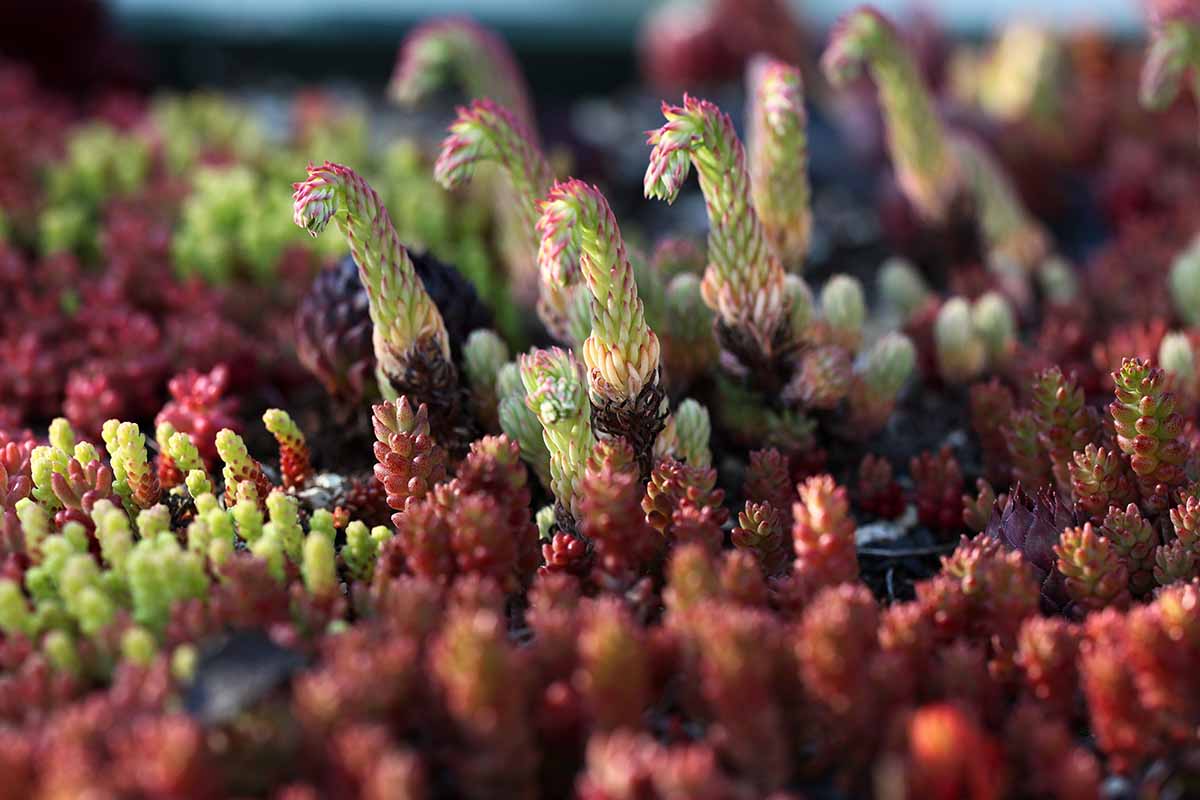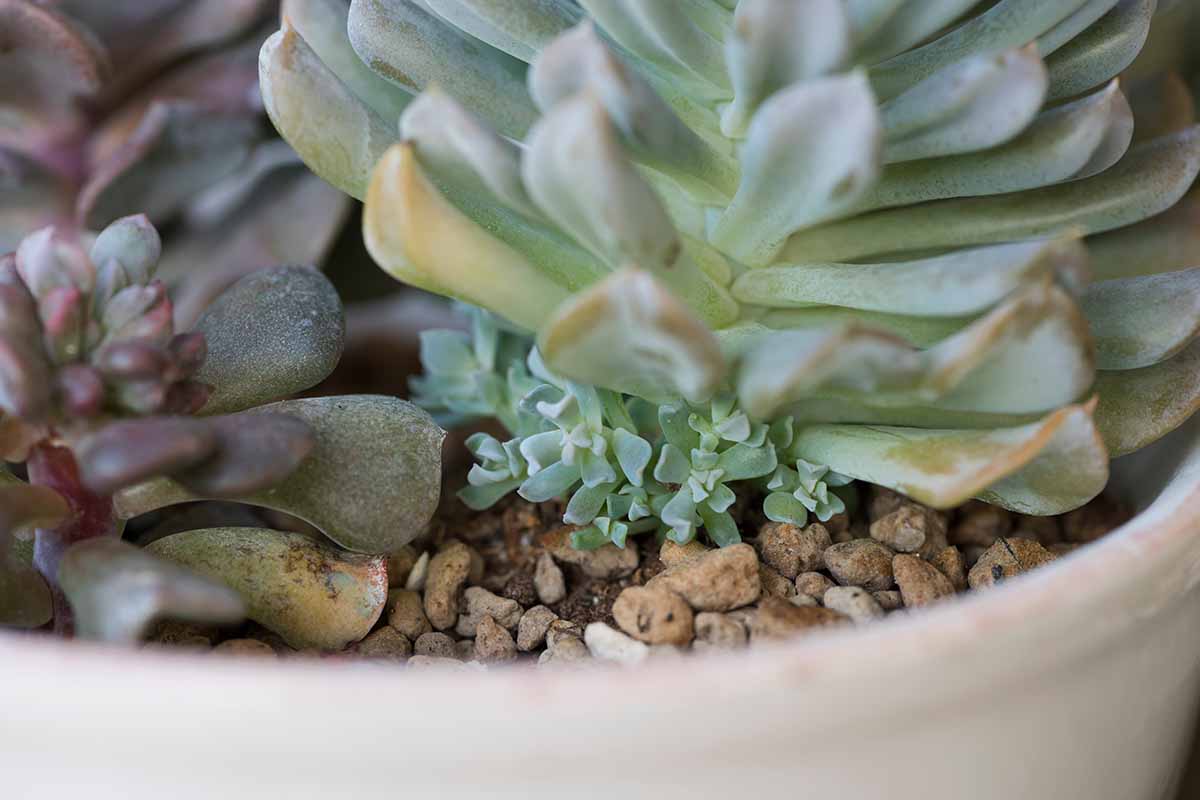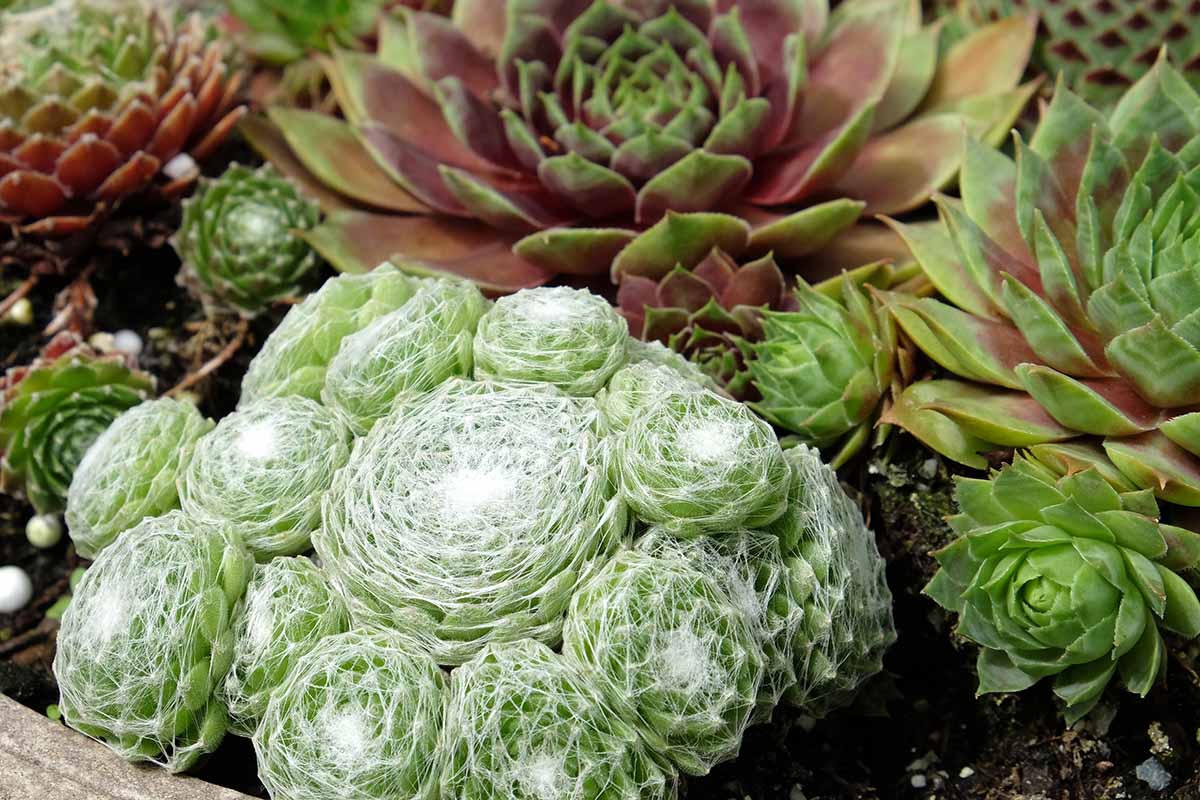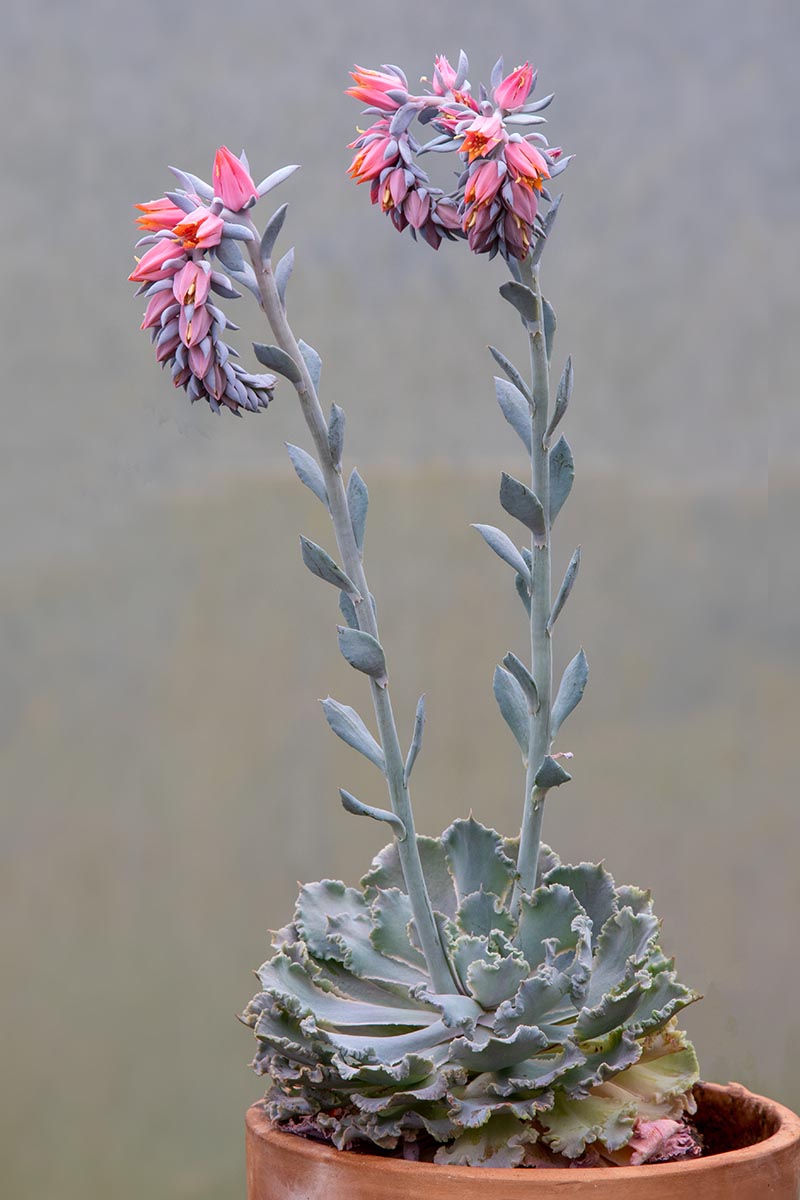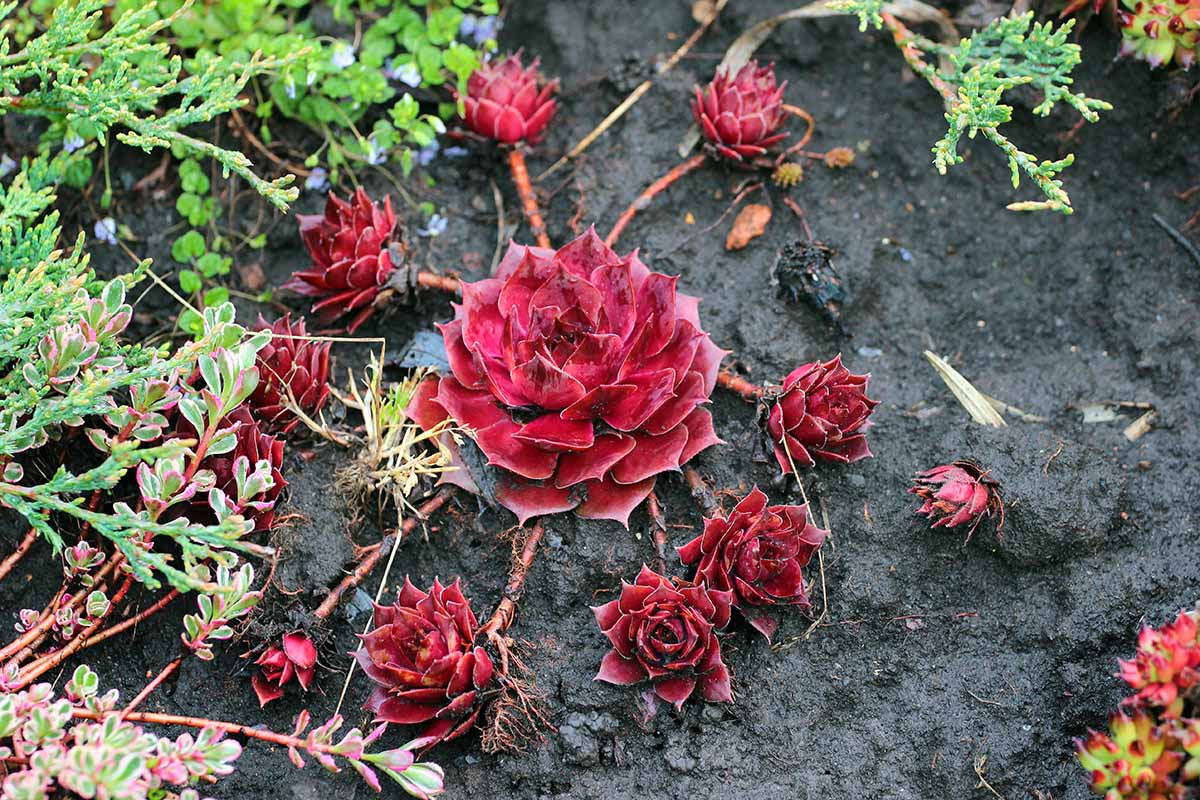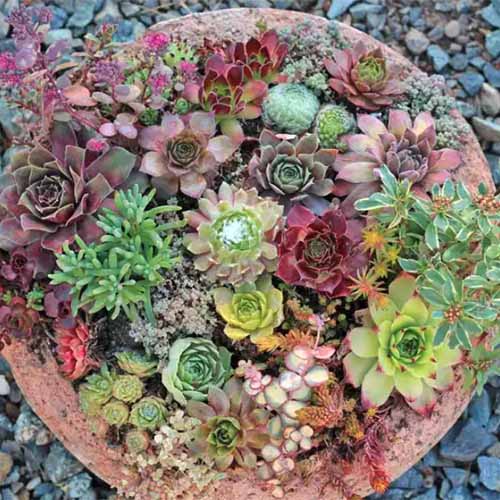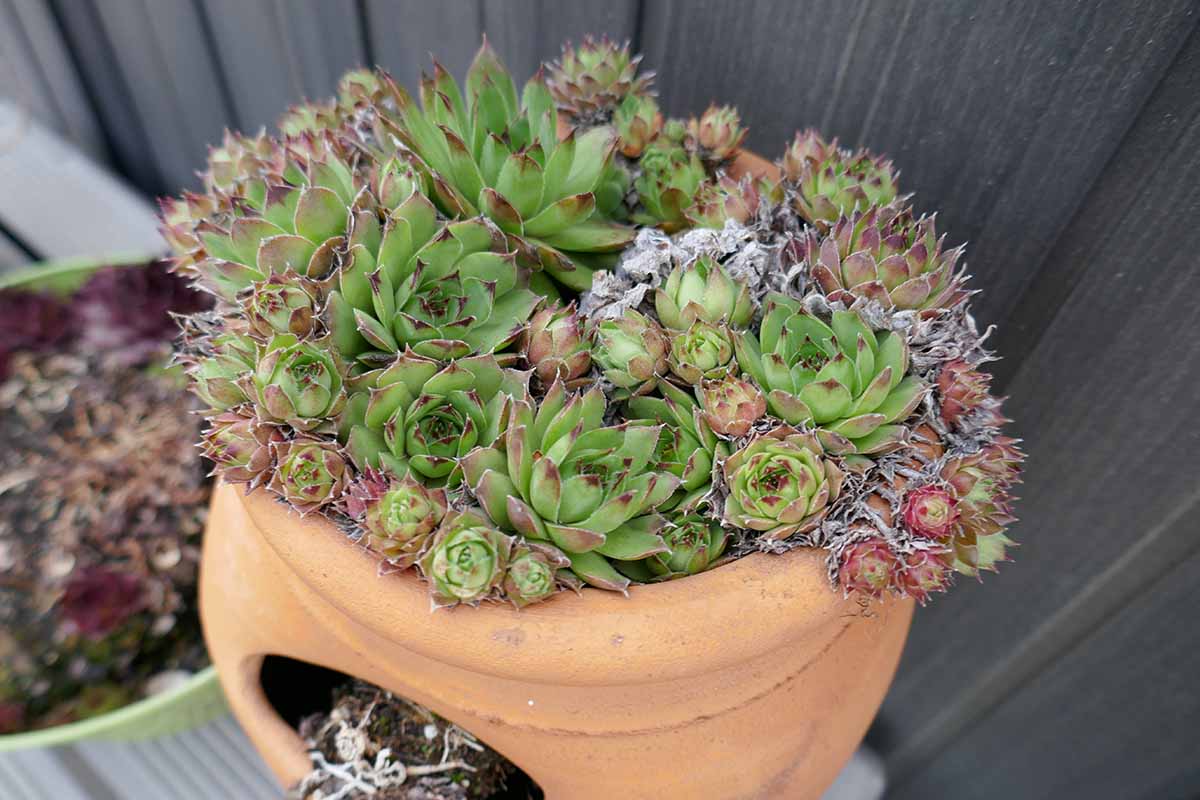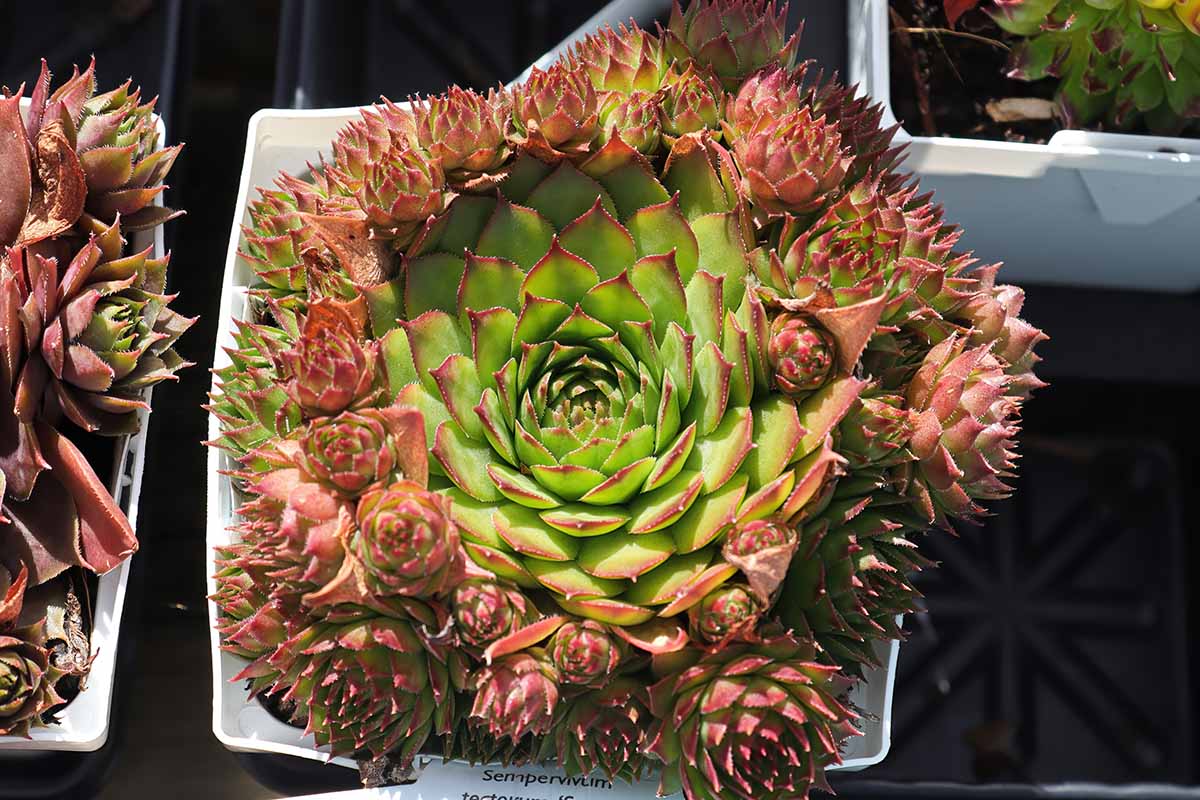We link to vendors to help you find relevant products. If you buy from one of our links, we may earn a commission. It’s a plant that means a lot to me personally and I’d love to share a little about that, but if you’re here strictly for the hard facts, check out the table of contents below to find exactly what you’re looking for! As a quick note, this guide will serve as a general growing guide for the most common Sempervivum species. Fortunately all Sempervivum have almost identical growing requirements!
What Is Hens and Chicks?
To begin, you might be wondering – which came first, the hen or the chick? I was maybe four or five years old when I first discovered Sempervivum. Hard to recall clearly because I was so young at the time, but I do remember the fieldstone-lined garden-bed-above-a-ditch my aunt and uncle tended. It was populated with a combination of marigolds, dusty miller, scattered weeds, and hens and chicks. “They’re called hens ‘n’ chicks,” my uncle said. “You got the mother, the hen,” – he pointed at the giant, succulent rosette in the soil – “and you got the chicks” – he tapped one of the smaller rosettes, a miniature of the mother. Idiot me-as-a-four/five-year-old bumped the giant rosette of the hen and accidentally released a chick, sending it rolling down to the ditch. Regret swallowed me whole by the time the little chick came to a stop at the bottom, but my uncle laughed it off. He picked it up and placed it between two fieldstones and scraped some sandy soil around it, patted me on the back, and told me not to worry. “That’s what they wanna do! Don’t be upset, you helped ‘em along the way.” I think it’s fair to say this defining moment was a deciding factor in my life ahead as a gardener.
Probably the Hen
It’s been a long time since my two semesters of Latin, but trust me when I say that Sempervivum means “always living” and tectorum is Latin for “roof.” Considering how easily houseleeks happily take hold in even the least hospitable environments, I’d say it’s a very apt name. They’ve been cultivated for a very long time and originated in southern Europe and northern Africa. It’s funny how humans have always carried their gardens with them, because this plant traveled the world early on and was brought to to western Europe by the Romans. Since then, it’s traversed the globe, and we’re all the richer for it. It’s been a popular plant in gardens ever since, especially in rock gardens and poor soils. In my mind, it’s the perfect kind of plant for the gardener who likes to crack open a beer at the end of a day at the job and get to work on what’s really important.
Propagation
Although it’s possible to grow hens and chicks from seed, it’s incredibly impractical compared to simply collecting a few chicks from a producing hen to propagate.
From Offsets
You’ve got a few options here: Let your mother “hen” Sempervivum produce tiny babies on its own, and let those babies spread around your garden as they like. Separated from the mother, they will naturally root in cracks in or spaces between stones, but the chicks are just as happy to grow anywhere you’ve got space for them. Your other option is to snip a few “chicks” free when they’ve formed roots and place them precisely where you want more to grow. The safest way to ensure both chick and hen survive is to wait for the runner, or stolon, that attaches them to dry completely and become brittle to the touch before separating the two. These “chicks” are little offshoots produced by the parent plant, spreading around the garden like the vines and spores that overrun the Upside Down in the fictional town of Hawkins, Indiana in “Stranger Things.” Each runner will produce some tiny leaves that it holds onto while the hen is still supporting the chick. Wait to move the chicks until the leaves die and the runner grows dry, thin, and brittle. It doesn’t get much easier than that!
Transplanting
Houseleeks can grow in richer soil and more hospitable conditions, but they can’t tolerate much moisture or any standing water. Hens and chicks don’t have very vigorous root systems. A. M. Leonard Deluxe Hori Hori Lightly backfill the hole and give it a good drink of water. Voila, instant gratification.
How to Grow
Sempervivum is one of those plants you risk killing only if you smother it with too much love and attention. All it wants is to be left alone in an area that is never very wet, basking in as much sun as you can throw at it. It can grow in most types of soil but is at its best when the soil quality is generally poor, rocky, and dry. I’ve had success growing them in beds with some very nice soil that also supported sweet woodruff and foxglove, but hens and chicks are plants best suited to those neglected areas in the garden. Don’t worry about fertilizing. Sempervivum prefers to figure out the nutrients on its own, which is fortunate – because it doesn’t need much. Seriously, this is one of those garden inhabitants that will trip over its own feet if it gets any kind of fertilization. Sempervivum won’t die from extra fertilization and will likely produce more runners and pups as a result, but generally, fertilization is mostly an issue of waste – hens and chicks just don’t need it. You’ll be a very generous plant parent indeed if you merely provide some leaf mold or compost once or twice a year. My favorite method of fertilizing hens and chicks is to simply clean up the area directly around the plants considerably less than anywhere else in the garden in fall and winter. Leaving healthy plant detritus and leaves in place acts as sufficient mulch as well as compost.
Growing Tips
Partial shade is tolerable, while full sun is desirable.Don’t worry about watering except in a severe drought.Ignore this plant! The hens can take care of their chicks!
Maintenance
You don’t need to worry about maintenance here. Caring for your hens and chicks in the long term is about as easy as it gets. Eventually, the mother hen will have had her fill of this world, and in celebration of the life she’s lived, she’ll raise a couple of flower stalks to the sky. Enjoy that beautiful sight, because it’s your mother hen’s only display of grandeur in a lifetime of satisfied withholding. After flowering, Sempervivum is done with the show and will die. I’m a devout believer in leaving any dead plant in the garden right where it is when it died, unless it’s something infected with disease. I’ve seen gardeners remove the dead hen and throw it in the compost or yard waste bin, but I think these understated, modest plants deserve to decompose at their own pace. Outside of that, Sempervivum doesn’t require much maintenance. You can weed around the rosettes if you’ve got an obnoxious or aggressive weed creeping in, but you can also leave those couple of sprigs of grass and purslane that are growing in the area if they don’t bother you. Trust me, they aren’t bothering the plant.
A Note on Flowering
Hens and chicks can produce a lovely flower, but this is also a signal that your plant is finishing its life cycle and about to die. It’s okay, because the flower produces seeds, and it has surely produced plenty of chicks in its lifetime to carry on the cycle. Enjoy the flower as a final show of gratitude from your hen, and get ready for a new rosette to take its place in the garden. You can read more about flowering in Sempervivum plants in this guide.
Cultivars to Select
You’ll find plenty of varieties of Sempervivum to fit your style and taste, as long as your style and taste favors rosettes with thick leaves covered with tiny white hairs. That means they all look more or less the same with a few differences between from one to the next. That’s also called a bad joke. We’ll take a gander at some of the more familiar varieties, and I’ll keep (most of) the inane commentary to myself.
Black Lotus
This hen ‘n’ chick says “green is NOT cool” and brandishes a red color year round. The colder it gets in the winter, the darker the red becomes until it’s a dark maroon. The rosettes will grow as much as eight inches in diameter and are just as happy to produce plenty of chicks as any other Sempervivum.
Mark Weller
Another option for adding reds and maroons in your garden, ‘Mark Weller’ will adopt a variety of colors based on how hot or how cold it is. The rosettes grow up to about five inches in diameter, and this cultivar tends to flower earlier in the season than other hens and chicks when the time comes. It’s also a bit more sensitive to sunlight, so offer ‘Mark Weller’ some shade to handle the hottest parts of the day, and maybe a glass of lemonade while you’re at it.
Royanum
In pleasing shades of green with purple-tipped rosettes measuring about five inches in diameter, ‘Royanum’ is a common find in the garden center because it’s got that iconic hens and chicks look. Just as easy to grow as other varieties, the two-tone leaves here make it an easy fit among plants of a variety of other colors.
Sirius
I like ‘Sirius’ for a couple of reasons, most of them being because I just think the plant is cool and a perfect example of hens and chicks. The rosettes will reach a maximum size of about four inches in diameter. As a bonus, this type has leaf tips that take on shades of orange, red, and burgundy while the rest of the plants remains light green. This is Sempervivum at its best: a low-maintenance plant of unassuming size happy to nest itself into the corners of your garden where nothing else will grow.
Wendy
A fuzzy little plant, it has the same red-tipped leaves as ‘Royanum,’ but the color is more pronounced with ‘Wendy.’ The more dense covering of tiny white hairs gives the plant a much softer look than its cousins, which could make it just the right addition in your garden. As a bonus, when you tell your friends about this one, you can impersonate Jack Nicholson from “The Shining” when you call it “Wendy.” As such, Sempervivum is very resistant to insect problems, though in the wrong conditions it might grow stressed and become host to a swarm. Assorted Hens and Chicks Prefer to be surprised? Four-packs of assorted hens and chicks in quart-size pots are available from Home Depot.
Managing Pests and Disease
You will be delighted to discover your hens and chicks don’t really face any common pest or disease issues, unless they’re experiencing conditions radically different from what they desire. I’ve never experienced an aphid or mealybug infestation on hens and chicks growing in the garden, but it’s happened with every plant I’ve tried growing indoors. Humid, wet environments with poor airflow are just not what Sempervivum wants to experience. You can spray the infestation with any insecticide you prefer but I think the best solution is a little rubbing alcohol on a cotton ball and some careful blotting of trouble areas in the rosette. Less is better in almost any situation – except in the case of ice cream, then it’s never enough… The best way to prevent aphids or mealybugs from striking is to keep some air moving around your plants and to ensure they’re growing in sunny, dry locations with excellent drainage.
Disease
Your plants might contract a fungal infection if they’re growing in very wet conditions, whether that’s indoors or out. Rust tends to be the most common culprit but infections are rare. You can ID this based on the telltale orange circles you’ll see scattered over the infected plant. A copper fungicide spray is the best solution when handling these issues if they arise. But usually, it’s best to dispose of the plant in the trash to prevent it from infecting other greenery in your garden. The ultimate tool to prevent fungal issues from happening in the first place is ensuring your hens and chicks are planted in dry conditions with fast-draining soil.
Best Uses
Hens and chicks are quintessential rock garden specimens. They will happily, readily, eagerly grow anywhere that’s mostly dry. That makes Sempervivum a perfect candidate for containers and those dry corners of the yard or garden where you’ve got to have something to fill in the space. They will grow well with other succulents that are hardy in your zone, but I think houseleeks grow best in a relatively naturalized setting. I’ve had luck growing them with heuchera, ornamental grasses, and echinacea, as well as other hardy succulents like prickly pear cactus or sedum. Generally, the best placement for Sempervivum is in a location with other plants that don’t want regular fertilization, or really, any attention at all. If you’ve got an expert hand in garden neglect like I do, you can put together a great looking, self-sustaining garden using plants like hens and chicks. They’re cute and quirky plants for the garden, something most people are going to instantly enjoy seeing and growing. And these are perfect examples of that special plant that demands little and provides ample appeal and interest in exchange, as well as being the rare succulent that can tolerate growing outdoors year-round in regions with cooler winters. As always, thank you for hanging out at Gardener’s Path. Please share your own stories about hens and chicks in the comments below. I feel like it’s a plant with countless devoted fans full of memorable stories. Until next time! By now you’re scribbling notes on what to grow with your Sempervivum, I suggest checking out the following growing guides. These cacti and succulents might be right up your alley as further additions to your indoor or outdoor space:
How to Grow Succulents Outdoors in the GardenHow to Grow and Care for Haworthia Indoors35 of the Best Hanging and Trailing Succulents and Cacti


